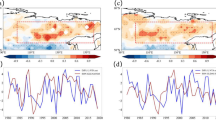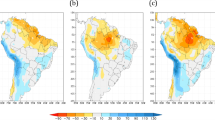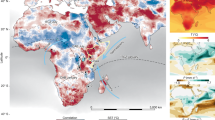Abstract
We investigated changes in the hydrological cycle in inner East Asia during the boreal summer (June-to-August) from 1979 to 2020 by analyzing climate variables including latent heat flux, precipitation and soil moisture. We found that the correlation between latent heat flux (LH) and precipitation varies across East Asia, with a negative correlation dominating over the summer monsoon region. In contrast, LH is positively correlated with precipitation in inner East Asia. Additional analyses indicate a positive correlation of LH-precipitation, implying a coupling of land and atmosphere that becomes strong in inner East Asia across the late 1990s. Soil moisture is also consistently and significantly reduced in inner East Asia after the late 1990s, which could be associated with the strengthening of a positive correlation of LH-precipitation. A tripole-like sea surface temperature (SST) in the North Atlantic Ocean causes anomalous anticyclonic circulation in inner East Asia through zonal wave propagation, resulting in a significant reduction of soil moisture. Our results indicate that the hydrological cycle in inner East Asia is influenced remotely by North Atlantic SST through soil moisture – precipitation feedback.







Similar content being viewed by others
Data availability
The dataset used in this study was the ECMWF Reanalysis v5 (ERA5) (Hersbach et al. 2020) and was downloaded from the Climate Data Store (https://cds.climate.copernicus.eu/cdsapp#!/home). Data processing such as Seasonal data, trend, regression and correlation analysis was performed using the Xarray library version 0.15.1 (Hoyer and Hamman 2017), the SciPy library version 1.2.1 (Virtanen et al. 2020) and NumPy library version 1.21.4 (Harris et al. 2020). The Figures were produced using the Matplotlib library version 3.0.3 (Hunter 2007).
References
Chahine MT (1992) The hydrological cycle and its influence on climate. Nature 359:373–380. https://doi.org/10.1038/359373a0
Dai A, Zhao T, Chen J (2018) Climate change and drought: a precipitation and evaporation perspective. Curr Clim Chang Rep 4:301–312. https://doi.org/10.1007/s40641-018-0101-6
Entekhabi D et al (2010) The soil moisture active passive (SMAP) mission. Proc IEEE 98:704–716. https://doi.org/10.1109/JPROC.2010.2043918
Gevaert A, Miralles DG, de Jeu RA, Schellekens J, Dolman AJ (2018) Soil moisture-temperature coupling in a set of land surface models. J Geophys Res Atmos 123:1481–1498. https://doi.org/10.1002/2017JD027346
Harris CR et al (2020) Array programming with NumPy. Nature 585:357–362. https://doi.org/10.1038/s41586-020-2649-2
Hersbach H et al (2020) The ERA5 global reanalysis. Q J R Meteorol Soc 146:1999–2049. https://doi.org/10.1002/qj.3803
Hoerling M et al (2014) Causes and predictability of the 2012 Great Plains drought. Bull Am Meteorol Soc 95:269–282. https://doi.org/10.1175/BAMS-D-13-00055.1
Hong C-C, Wu Y-K, Sallis P (2018) Influence of climate regime shift on the abrupt change of tropical cyclone activity in various genesis regions. In: Extreme Weather. IntechOpen Croatia. https://doi.org/10.5772/intechopen.74947
Hoyer S, Hamman J (2017) Xarray: ND labeled arrays and datasets in Python. J Open Res Softw 5. https://doi.org/10.5334/jors.148
Hsu H, Dirmeyer PA (2022) Deconstructing the Soil moisture–latent heat flux relationship: the range of coupling regimes experienced and the Presence of Nonlinearity within the Sensitive Regime. J Hydrometeorol 23:1041–1057. https://doi.org/10.1175/JHM-D-21-0224.1
Huang W, Wang B, Wright JS, Chen R (2016) On the non-stationary relationship between the siberian high and Arctic Oscillation. PLoS ONE 11:e0158122. https://doi.org/10.1371/journal.pone.0158122
Hunter JD (2007) Matplotlib: a 2D graphics environment. Comput Sci Eng 9:90–95. https://doi.org/10.1109/MCSE.2007.55
Karl T et al (2012) US temperature and drought: recent anomalies and trends. Eos 93:473–474. https://doi.org/10.1029/2012EO470001
Koutsoyiannis D (2020) Revisiting the global hydrological cycle: is it intensifying? Hydrol Earth Syst Sci 24:3899–3932. https://doi.org/10.5194/hess-24-3899-2020
Krakauer N, Cook B, Puma M (2010) Contribution of soil moisture feedback to hydroclimatic variability. Hydrol Earth Syst Sci 14:505–520. https://doi.org/10.5194/hess-14-505-2010
Kundzewicz ZW (2008) Climate change impacts on the hydrological cycle. Ecohydrol Hydrobiol 8:195–203. https://doi.org/10.2478/v10104-009-0015-y
Lee YH, Yeh SW, Hong JS, Shin J, An SI (2023) Regime shift increase in East Asia’s summer extreme hot day frequency across the late 1990s. Int J Climatol 43:2305–2317. https://doi.org/10.1002/joc.7976
Liu Y et al (2015) Agriculture intensifies soil moisture decline in Northern China. Sci Rep 5:11261. https://doi.org/10.1038/srep11261
Méndez-Barroso LA, Vivoni ER, Watts CJ, Rodríguez JC (2009) Seasonal and interannual relations between precipitation, surface soil moisture and vegetation dynamics in the north American monsoon region. J Hydrol 377:59–70. https://doi.org/10.1016/j.jhydrol.2009.08.009
Miralles DG, Van Den Berg M, Teuling A, De Jeu R (2012) Soil moisture-temperature coupling: a multiscale observational analysis. Geophys Res Lett 39
Namias J (1983) Some causes of United States drought. J Appl Meteorol Climatology 22:30–39. https://doi.org/10.1175/1520-0450(1983)022%3C0030:SCOUSD%3E2.0.CO;2
Ning L, Qian Y (2009) Interdecadal change in extreme precipitation over South China and its mechanism. Adv Atmos Sci 26:109–118. https://doi.org/10.1007/s00376-009-0109-x
Ohmura A, Wild M (2002) Is the hydrological cycle accelerating? Science 298:1345–1346. https://doi.org/10.1126/science.1078972
Oki T, Kanae S (2006) Global hydrological cycles and world water resources. Science 313:1068–1072. https://doi.org/10.1126/science.1128845
Rind D, Rosenzweig C, Goldberg R (1992) Modelling the hydrological cycle in assessments of climate change. Nature 358:119–122. https://doi.org/10.1038/358119a0
Rodionov SN (2004) A sequential algorithm for testing climate regime shifts. Geophys Res Lett 31. https://doi.org/10.1029/2004GL019448
Rodionov SN (2006) Use of prewhitening in climate regime shift detection. Geophys Res Lett 33. https://doi.org/10.1029/2006GL025904
Seneviratne SI, Lüthi D, Litschi M, Schär C (2006) Land–atmosphere coupling and climate change in Europe. Nature 443:205–209. https://doi.org/10.1038/nature05095
Seneviratne SI et al (2010) Investigating soil moisture–climate interactions in a changing climate: a review. Earth-Sci Rev 99:125–161. https://doi.org/10.1016/j.earscirev.2010.02.004
Seo Y-W, Ha K-J (2022) Changes in land-atmosphere coupling increase compound drought and heatwaves over northern East Asia. npj Clim Atmos Sci 5:100. https://doi.org/10.1038/s41612-022-00325-8
Takaya K, Nakamura H (1997) A formulation of a wave-activity flux for stationary Rossby waves on a zonally varying basic flow. Geophys Res Lett 24:2985–2988. https://doi.org/10.1029/97GL03094
Takaya K, Nakamura H (2001) A formulation of a phase-independent wave-activity flux for stationary and migratory quasigeostrophic eddies on a zonally varying basic flow. J Atmos Sci 58:608–627. https://doi.org/10.1175/1520-0469(2001)058%3C0608:AFOAPI%3E2.0.CO;2
Teuling AJ et al (2013) Evapotranspiration amplifies European summer drought. Geophys Res Lett 40:2071–2075. https://doi.org/10.1002/grl.50495
Tuinenburg OA, Theeuwen JJ, Staal A (2020) High-resolution global atmospheric moisture connections from evaporation to precipitation. Earth Syst Sci Data 12:3177–3188. https://doi.org/10.5194/essd-12-3177-2020
Virtanen P et al (2020) SciPy 1.0: fundamental algorithms for scientific computing in Python. Nat Methods 17:261–272. https://doi.org/10.1038/s41592-019-0686-2
Vivoni ER et al (2007) Variation of hydrometeorological conditions along a topographic transect in northwestern Mexico during the north American monsoon. J Clim 20:1792–1809. https://doi.org/10.1175/JCLI4094.1
Vivoni ER, Gebremichael M, Watts CJ, Bindlish R, Jackson TJ (2008) Comparison of ground-based and remotely-sensed surface soil moisture estimates over complex terrain during SMEX04. Remote Sens Environ 112:314–325. https://doi.org/10.1016/j.rse.2006.10.028
Von Storch H, Navarra A (1999) Analysis of climate variability: applications of statistical techniques. Springer Science & Business Media
Wang B, Ding Q (2006) Changes in global monsoon precipitation over the past 56 years. Geophys Res Lett 33. https://doi.org/10.1029/2005GL025347
Wang B, Liu J, Kim H-J, Webster PJ, Yim S-Y (2012) Recent change of the global monsoon precipitation (1979–2008). CLIM DYNAM 39:1123–1135
Wild M, Grieser J, Schär C (2008) Combined surface solar brightening and increasing greenhouse effect support recent intensification of the global land-based hydrological cycle. Geophys Res Lett 35. https://doi.org/10.1029/2008GL034842
Yang L, Sun G, Zhi L, Zhao J (2018) Negative soil moisture-precipitation feedback in dry and wet regions. Sci Rep 8:4026. https://doi.org/10.1038/s41598-018-22394-7
Zahn M, Allan RP (2013) Climate warming–related strengthening of the tropical hydrological cycle. J Clim 26:562–574. https://doi.org/10.1175/JCLI-D-12-00222.1
Zhang J, Wu L, Dong W (2011) Land-atmosphere coupling and summer climate variability over East Asia. J Geophys Res Atmos 116. https://doi.org/10.1029/2010JD014714
Zhang P et al (2020) Abrupt shift to hotter and drier climate over inner East Asia beyond the tipping point. Science 370:1095–1099. https://doi.org/10.1126/science.abb3368
Zhou B, Wen QH, Xu Y, Song L, Zhang X (2014) Projected changes in temperature and precipitation extremes in China by the CMIP5 multimodel ensembles. J Clim 27:6591–6611. https://doi.org/10.1175/JCLI-D-13-00761.1
Zhou S et al (2021) Soil moisture–atmosphere feedbacks mitigate declining water availability in drylands. Nat Clim Change 11:38–44. https://doi.org/10.1038/s41558-020-00945-z
Acknowledgements
We acknowledge the ECMWF for providing the dataset in the paper.
Funding
This work was supported by Korea Environment Industry and Technology Institute (KEITI) through-Climate Change R&D Project for New Climate Regime funded by Korea Ministry of Environment (MOE) (2022003560001).
Author information
Authors and Affiliations
Corresponding author
Ethics declarations
Competing interests
The authors declare that they have no known competing financial interests or personal relationships that could have appeared to influence the work reported in this paper.
Additional information
Publisher’s Note
Springer Nature remains neutral with regard to jurisdictional claims in published maps and institutional affiliations.
Rights and permissions
Springer Nature or its licensor (e.g. a society or other partner) holds exclusive rights to this article under a publishing agreement with the author(s) or other rightsholder(s); author self-archiving of the accepted manuscript version of this article is solely governed by the terms of such publishing agreement and applicable law.
About this article
Cite this article
Jeon, JG., Yeh, SW. & Song, SY. Changes in the hydrological properties of inner East Asia during the boreal summer and possible mechanisms. Clim Dyn (2024). https://doi.org/10.1007/s00382-024-07234-x
Received:
Accepted:
Published:
DOI: https://doi.org/10.1007/s00382-024-07234-x




